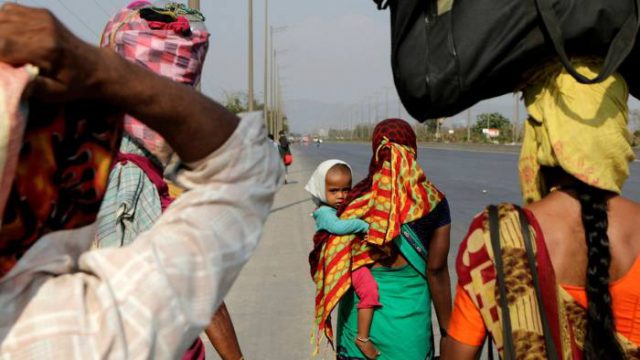The Covid-19 pandemic has revealed the open secret of the Indian economy, and its inability and failure to support the backbone of the industrial prowess – the 114 million strong, ductile and undemanding work-force and migrant labourers that have been left in the lurch during the eight-week-long lockdown (as we go to print.)
Mass exodus
The workplaces are shut or denied access and most contractors and business links vanished leaving the workers migrating from different parts of the country, in refugee-like conditions. This was the eighth biggest exodus in India, and while some we can recall easily the 1947 partition which displaced nearly 15 million people, the 1971 Indo-Pak War, and the expulsion of the Kashmiri Pandits from the Kashmir valley in 1990; Covid-19 is nothing short of mass displacement of migrants.
The workers contribute to some of the most fundamental factors of economic growth, but in a totally unsung manner. The unorganised workforce which sustains the big cities’ economic sustenance in terms of construction labour, industrial work force, domestic help, or serving as roadside tradesmen, have left the urban environs desolate, disappointed and dejected.
The administration could not fathom the importance, need, and inclusiveness of this potent force to reboot the economy which was hit and hammered by the lockdown. The migrant workers were turned into refugees overnight, patience and money ran out, the crying kids in hunger and the fear of the virus was unbearable.
They waited for the assurances of leaders, mentors, and Maliks to provide hope, health, and home, but that was not to be. The mind gave marching orders to the feet to head for villages where brotherhood, bonhomie, and bread was there not only for humans but for the animals too. The exodus began, the most appreciable thing was their grit, determination, and love for environment which may not be opulent but optimistic in thinking and living.
The sudden lockdown in a couple of hours left the workers in surprise and ignorant about the options and consequences. The role of small business owners was understandable because of their lack or low resilience in terms of sustainability, but the bigger business houses were expected to rise to the occasion to support the very foundation of the industrial empire.
Inadequate support
The requirement of workers was Roti, Makan, Rozgar, and Swabhiman. The various elite and the so-called confederations of industries, associations, and guilds could not muster courage, conviction, and conscience to help the deprived and desolate people on whom they celebrate the success of moola muscularity. Here lies the difference between an industrialist and business men.
Ratan Tata, or for that matter the Tata group of industrialists, are true capitalists who take their team along, look after them during times of crisis. With a workforce as huge as 450,000, spanning 96 companies being run by charitable trusts are one of the few mention-worthy names in the current scenario.
The other big names in industrial circles are businessmen with the sole aim to churn profits and use the workforce as cannon fodder. The difference between the industrialists and businessmen is that industrialists create wealth and businessmen create profits.
The problem of housing and dwelling could have been addressed by using the vacant schools and educational institutes duly, following the social distancing norms as they have enough space to accommodate. The disbursed dwelling would have given the workers shelter and security. The same workforce under mentorship could have been used to manufacture items like masks, cleaning the environment, undertaking over-delayed projects, thereby creating jobs, keeping them meaningfully employed and earning livelihood with Swabhiman.
A world of difference
The problem was global and some countries addressed this in a mature and meticulous way like in the UK, where our Indian-origin young turk Rishi Munak announced a wage protection package. Brazil launched an Emergency salary programme, Japan adopted a cash delivery model. The Indian Government’s Jan Dhan Yojna is an appreciable step in the right direction but the remittance was pittance, and the same could have been increased by reducing the distribution chains and links who take their own pound of flesh.
Finally, the anatomy of an industrial empire has three type of bones – the jaw bones who talk and do sweet little, the knuckle bones who knock at all doors to find out what’s brewing and do nothing, and the back bones (workers) who get down to work and make all the difference in the industrial yield curve. The nation should look after this asset because the remigration will be an uphill task to get the men back to the machines. We must salute the worker warriors like Jyoti who cycled 1200 km to lug her ailing relative from Delhi to Darbhanga, Gayoor Ahmed who tricycled his way to home, and Yakoob who refused to abandon ailing Amrit Kumar. All is still not lost and the federal governments, along with the Centre must revisit, restructure, redesign, and revamp the migration of workers in order to restore the industry and the industrial workers.

Brig (Dr) Vinod Dutta
Brigadier Dr Vinod Dutta has almost three decades of experience in Disaster & Crisis Management, Response, Relief & Recovery, Supply Chain Logistics, and Training. Theformer Secretary, DCMG (Disaster Management), the Brigadier handled supply Chain Logistics during the KARGIL war, has been the Logistics Advisor to The Royal Govt of Bhutan and a faculty at prestigious colleges with a double masters in Management & Strategic Studies, a Law degree, M Phil in Management & PhD.

![Powerful Pride documentary Legendary Children [All Of Them Queer] streaming very soon](https://globalindianstories.org/wp-content/uploads/2025/06/Legendary-streaming-release-featured-238x178.jpg)



![Powerful Pride documentary Legendary Children [All Of Them Queer] streaming very soon](https://globalindianstories.org/wp-content/uploads/2025/06/Legendary-streaming-release-featured-100x75.jpg)

